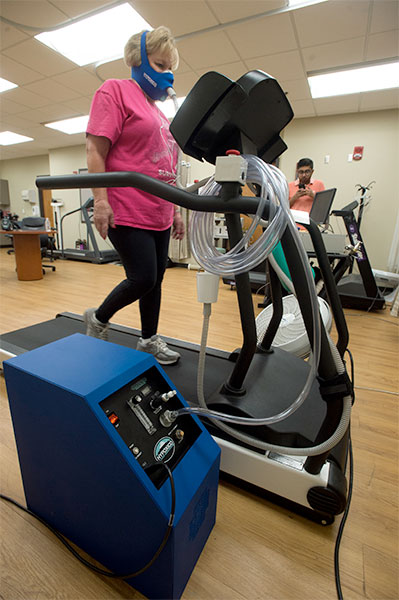Researchers at the University of Alabama at Birmingham School of Health Professions are rethinking the exercise paradigm for breast cancer survivors.
Though exercise training at high altitude has been employed by endurance athletes for many years, there is a growing interest in the therapeutic potential of hypoxic exercise training to improve cardio-metabolic health among clinical populations.
Stephen J. Carter, Ph.D., postdoctoral fellow in the Department of Nutrition Sciences, and colleagues are able to deliver a lower fraction of inspired oxygen to exercising participants in an effort to simulate an altitude nearing 7,000 feet.
This novel approach to exercise is being evaluated among obese breast cancer survivors with restricted walking capabilities. Researchers hope that the combination of exercise coupled with hypoxic conditions, termed intermittent normobaric hypoxia, may be used to stimulate a host of physiological changes to improve overall health and ability to perform activities of daily living with greater ease in breast cancer survivors.
 60 percent of breast cancer survivors have some form of lower-body joint dysfunction.According to a 2009 study, 60 percent of breast cancer survivors have some form of lower-body joint dysfunction, in addition to the precipitous decline in cardiorespiratory fitness following cancer treatment – the ability to be physically active is troublesome for many breast cancer survivors.
60 percent of breast cancer survivors have some form of lower-body joint dysfunction.According to a 2009 study, 60 percent of breast cancer survivors have some form of lower-body joint dysfunction, in addition to the precipitous decline in cardiorespiratory fitness following cancer treatment – the ability to be physically active is troublesome for many breast cancer survivors.
“The direct and indirect effects of cancer treatment can create, in some, a reinforcing pattern of avoidance of activity, which subsequently hastens deconditioning and weight gain,” Carter said. “As the benefits of habitual exercise are largely known, we’re interested in determining whether we can optimize the exercise stimulus for a given effort.”
Carter noted that, since it is known habitual exercise is remarkably effective, the next logical question is trying to understand whether his team can create a situation that readily boosts physiological adaptations.
“High-intensity interval exercise has been employed to elicit such effects, yet this approach may not be initially appropriate given the high prevalence of comorbid conditions among breast cancer survivors,” he said.
Following a battery of baseline tests, participants randomized to the “altitude group” are asked to perform a systematic, eight-week exercise training regimen in hypoxic conditions (≈16 percent oxygen) while the “control group” performs exercise under normal conditions (≈21 percent oxygen). To simulate a higher altitude, participants are outfitted with an exercise mask connected to a commercial grade hypoxic generator that rarifies room air. A light-weight corrugated tube from the generator is connected to the exercise mask, which is secured over the participant’s mouth and nose with neoprene straps and does not impede the participant’s ability to speak. The two groups follow the same exercise progression based on the heart rate reserve method.
“In hypoxic conditions, the resulting decrease in blood oxygen saturation upregulates the cardiovascular system to maintain appropriate tissue perfusion and ensure oxygen delivery matches oxygen demands,” Carter said. “This approach allows the altitude group to walk at slower speeds, which is believed to mitigate joint discomfort and local muscle fatigue.”
Carter does not necessarily think this is a long-term solution to exercise, but instead a strategy to readily support a better cardio/metabolic profile and provide the physiologic tools to engage in more free-living physical activity.
Eligible participants for this investigation must have a history of breast cancer, reside in or near Jefferson County, Alabama, be between the ages of 18 and 70, and have a body mass index between 30 and 45 kg/m2. Volunteers will be asked to attend two assessment sessions: an initial assessment and another after eight weeks of exercise training to collect information about health status. Further eligibility screening will be conducted by telephone.
To find out more information about how to participate in this clinical trial, please contact the UAB Exercise and Cancer Research Team at 205-975-0269 or moveforward@uab.edu.